
Olive Oyl is a cartoon character created by E. C. Segar in 1919 for his comic strip Thimble Theatre. The strip was later renamed Popeye after the sailor character that became the most popular member of the cast; however, Olive Oyl was a main character for a decade before Popeye's 1929 appearance.

Bluto, at times known as Brutus, is a cartoon and comics character created in 1932 by Elzie Crisler Segar as a one-time character, named "Bluto the Terrible", in his Thimble Theatre comic strip. Bluto made his first appearance on September 12 of that year. Fleischer Studios adapted him the next year (1933) to be the main antagonist of their theatrical Popeye animated cartoon series.
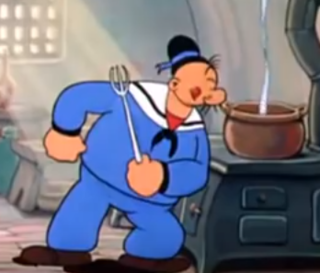
J. Wellington Wimpy, generally referred to as Wimpy, is one of the characters in the comic strip Popeye, created by E. C. Segar and originally called Thimble Theatre, and in the Popeye cartoons based upon the strip. Wimpy debuted in the strip in 1931 and was one of the dominant characters in the newspaper strip, but when Popeye was adapted as an animated cartoon series by Fleischer Studios, Wimpy became a minor character; Dave Fleischer said that the character in the original Segar strip was "too smart" to be used in the film cartoon adaptations. Wimpy appears in Robert Altman's 1980 live-action musical film Popeye, played by Paul Dooley.

Elzie Crisler Segar, known by the pen name E. C. Segar, was an American cartoonist best known as the creator of Popeye, a pop culture character who first appeared in 1929 in Segar's comic strip Thimble Theatre.

Eugene the Jeep is a character in the Popeye comic strip. A mysterious animal with magical or supernatural abilities, the Jeep first appeared in the Thimble Theatre comic strip. He was also present in animated versions of Popeye's adventures, including three of the Fleischer Studios shorts of the late 1930s/early 1940s, with more extensive appearances in later Popeye cartoons produced for TV.
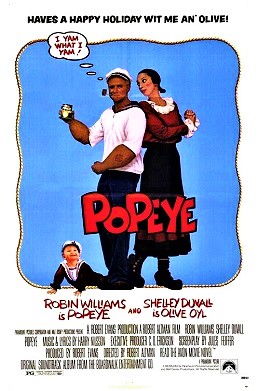
Popeye is a 1980 American musical comedy film directed by Robert Altman and produced by Paramount Pictures and Walt Disney Productions. It is based on E. C. Segar's Popeye comics character. The script was written by Jules Feiffer, and stars Robin Williams as Popeye the Sailor Man and Shelley Duvall as Olive Oyl. Its story follows Popeye's adventures as he arrives in the town of Sweethaven.

Popeye the Sailor Meets Sindbad the Sailor is a 1936 two-reel animated cartoon short subject in the Popeye Color Specials series, produced in Technicolor and released to theatres on November 27, 1936, by Paramount Pictures. It was produced by Max Fleischer for Fleischer Studios and directed by Dave Fleischer, with the title song's music composed by Sammy Timberg and lyrics written by Bob Rothberg. The voice cast includes Jack Mercer as Popeye, Gus Wickie as Sindbad the Sailor, Mae Questel as Olive Oyl and Lou Fleischer as J. Wellington Wimpy.
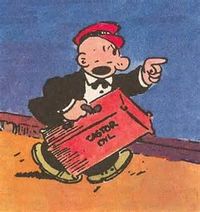
Castor Oyl is a fictional character, created in 1920 by cartoonist Elzie Crisler Segar for his comic strip Thimble Theatre, now known as Popeye.

Popeye's Voyage: The Quest for Pappy is a 2004 computer-animated Christmas television special produced by Mainframe Entertainment for Lions Gate Entertainment and King Features Entertainment, in association with Nuance Productions. The special, created to coincide with the 75th anniversary of the Popeye the Sailor comic strip character from E. C. Segar's Thimble Theatre, first aired on Fox on December 17, 2004, and was rebroadcast on the same network on December 30, 2005.
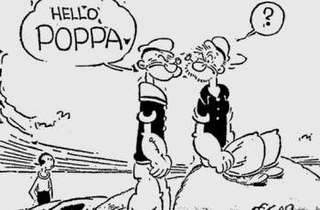
Poopdeck Pappy is a fictional character featured in the Popeye comic strip and animated cartoon spinoffs. Created by E. C. Segar in 1936, the character is Popeye's father, who is between the ages of 85 and 99.
Swee'Pea is a character in E. C. Segar's comic strip Thimble Theatre / Popeye and in the cartoon series derived from it. His name refers to the flower known as the sweet pea. Before his addition to the animated shorts, the name "Sweet Pea" was a term of affection used by main character Popeye. In the cartoon We Aim to Please, he addressed girlfriend Olive Oyl that way.
Alice the Goon is a fictional character in E. C. Segar's comic strip Thimble Theatre and in the Popeye cartoon series derived from it.
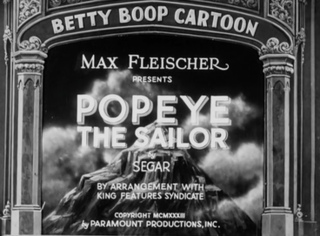
Popeye the Sailor is a 1933 animated short produced by Fleischer Studios and distributed by Paramount Publix Corporation. While billed as a Betty Boop cartoon, it was produced as a vehicle for Popeye in his debut animated appearance.
Olive Oyl for President is a 1948 entry in the Popeye the Sailor animated short subject series, produced by Famous Studios and released on January 30, 1948 by Paramount Pictures. The short is a reworking of a 1932 Betty Boop cartoon, Betty Boop for President, and depicts what Popeye imagines the world would be like if Olive Oyl were president.

Popeye the Sailor is an American animated television series produced for King Features Syndicate TV starring Popeye that was released between 1960 and 1963 with 220 episodes produced. The episodes were produced by a variety of production studios and aired in broadcast syndication until the 1990s.

The All New Popeye Hour is an American animated television series produced by King Features Entertainment In association with Hanna Barbera Productions. Starring the comic strip character Popeye, the series aired from 1978 to 1983 Saturday mornings on CBS. Despite the series' mixed reception, it was a hit for King Features Entertainment.
George W. Geezil, also known as simply Geezil, is a comic strip character created by E. C. Segar for his strip Thimble Theatre in 1932.

Popeye the Sailor is an American animated series of short films based on the Popeye comic strip character created by E. C. Segar. In 1933, Max and Dave Fleischer's Fleischer Studios, based in New York City, adapted Segar's characters into a series of theatrical cartoon shorts for Paramount Pictures. The plotlines in the animated cartoons tended to be simpler than those presented in the comic strips, and the characters slightly different. A villain, usually Bluto, makes a move on Popeye's "sweetie", Olive Oyl. The villain clobbers Popeye until he eats spinach, giving him superhuman strength. Thus empowered, Popeye makes short work of the villain.

The Sea Hag is a fictional character owned by King Features Syndicate. She is a tall, masculine-looking witch featured in comics/cartoons as a nemesis to the character Popeye. The Sea Hag was created by Elzie Crisler Segar in 1929 as part of the Thimble Theatre comic strip.

Popeye the Sailor is a fictional cartoon character created by Elzie Crisler Segar. The character first appeared on January 17, 1929, in the daily King Features comic strip Thimble Theatre. The strip was in its tenth year when Popeye made his debut, but the one-eyed sailor quickly became the lead character, and Thimble Theatre became one of King Features' most popular properties during the 1930s. Following Segar's death in 1938, Thimble Theatre was continued by several writers and artists, most notably Segar's assistant Bud Sagendorf. The strip continues to appear in first-run installments on Sundays, written and drawn by R. K. Milholland. The daily strips are reprints of old Sagendorf stories.
















